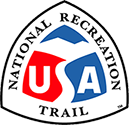




The trail runs along the Spokane River for 37 miles from the Idaho state line to Nine Mile Falls, Washington. The paved trail is used both for commuting to work and for recreation.


Designated in 2010
• View more details for this trail
in the NRT Database
• Learn about the NRT Program.
The Spokane Centennial Trail comprises 37 miles of natural beauty following the historic Spokane River from the Idaho state line to Nine Mile Falls, WA. The Trail has something for everyone. Walk or run, bike or in-line skate, or simply enjoy nature. Picnic on the river’s edge, launch a canoe, or just sit and contemplate the rhythmic flow of the river. Designed for use by people of all ages and physical capabilities, the Trail is fully paved, so it is ADA accessible. It is used for commuting to both work and pleasure, and wildlife observation.
With its metropolitan center section in downtown Spokane, the Centennial Trail branches out to more rural west and east endpoints, reaching into Idaho, for a total of 61 miles. It mostly follows the contours of the Spokane River and joins up with Lake Coeur d’Alene, Idaho, connecting along the way with the Liberty Lake Trail, Plantes Ferry Link Trail, and Cheney-Fish Lake Trail.
There are over 2 million uses per year on the Trail. It is not only a free resource for the community, but a destination location. The Trail provides a great venue for family events, youth involvement such as school planting projects and Boy Scouts helping with the annual Unveil the Trail clean up, and fundraising by nonprofit groups.
In 1979, Spokane County Parks proposed a bicycle/pedestrian pathway along the Spokane River. In 1984, the Spokane Valley Chamber of Commerce formed a Parks and Recreation Committee to explore this recreational possibility. In 1986, this group proposed a 10.5-mile recreational trail in the valley, naming it a Centennial Trail to coincide with Washington State’s 100th birthday in 1989. In 1987, the internationally recognized architectural team, Jones & Jones, was selected to develop a master plan for the Centennial Trail.
It took a community to build the trail system - fundraisers, volunteers, and local businesses. In 1991, the Friends of the Centennial Trail was created, a nonprofit Washington corporation, dedicated to the ongoing support of the public sector for the development, operation, maintenance, and enhancement of the Spokane Centennial Trail.
With the cooperation of the entire community, roughly 30 miles of class 1 trail were completed by 1992. The remaining seven miles consists of class 2 and 3 trail to create a contiguous trail system. The Trail is maintained via a cooperative agreement between the Washington State Parks & Recreation Commission and the city and county parks departments and assisted by the Friends of the Centennial Trail.
To help raise funds to maintain the Trail, an Adopt a Mile program was created, as was a Miracle Mile program with donors’ names on medallions on the Trail. The Trail includes the Spokane House Interpretive Center and historical interpretative kiosks and statues.
The EXPO '74 World's Fair became the event that transformed downtown Spokane. EXPO restored the riverfront's openness and public access. Lilac Bloomsday Run, the largest timed road race in the world, is held annually in Spokane.The Friends of the Centennial Trail move forward with proposed projects including underpasses, routing under bridges, realignment, and extension. Updated signage for Adopt a Mile groups, mile-marker posts, and route signs also are planned.
The police department for each jurisdiction enforces security. In the summer Sheriff officers ride the Trail daily. Washington State Parks rangers also ride the whole Trail. Together they enforce Trail rules. Events on the Trail require permits with a safety plan. Each year park rangers train SCOPE (Sheriff Community Oriented Policing Effort) volunteers who patrol the Trail and trailheads in the Spokane Valley section.
Users include groups such as the Spokane Bicycle Club, Bloomsday Road Runners Club, Spokane Mountaineers, Rotary Clubs, and Kiwanis Clubs.
Non-motorized vehicles only (exception: wheelchairs) Trail hours: dawn to dusk, year-round No alcoholic beverages or firearms on the Trail Speed limit: 15 m.p.h. maximum Pets must be under control and on a six foot or shorter leash at all times Pack it in... Pack it out!
Along the Spokane River starting at the State Line of Idaho off of I-90, exit 299. The Trail then runs mostly by the river for 37 miles to Nine Mile Falls, WA. There are many access points to get on the trail and 14 trailheads.
The Centennial Trail has many recreation centers along its route, including Sontag Park, Riverside State Park and campground, canoe/kayak launch sites, an equestrian center, Riverfront Park, Mission Park, John T. Shield Park, Plantes Ferry Park, and Sullivan County Park.